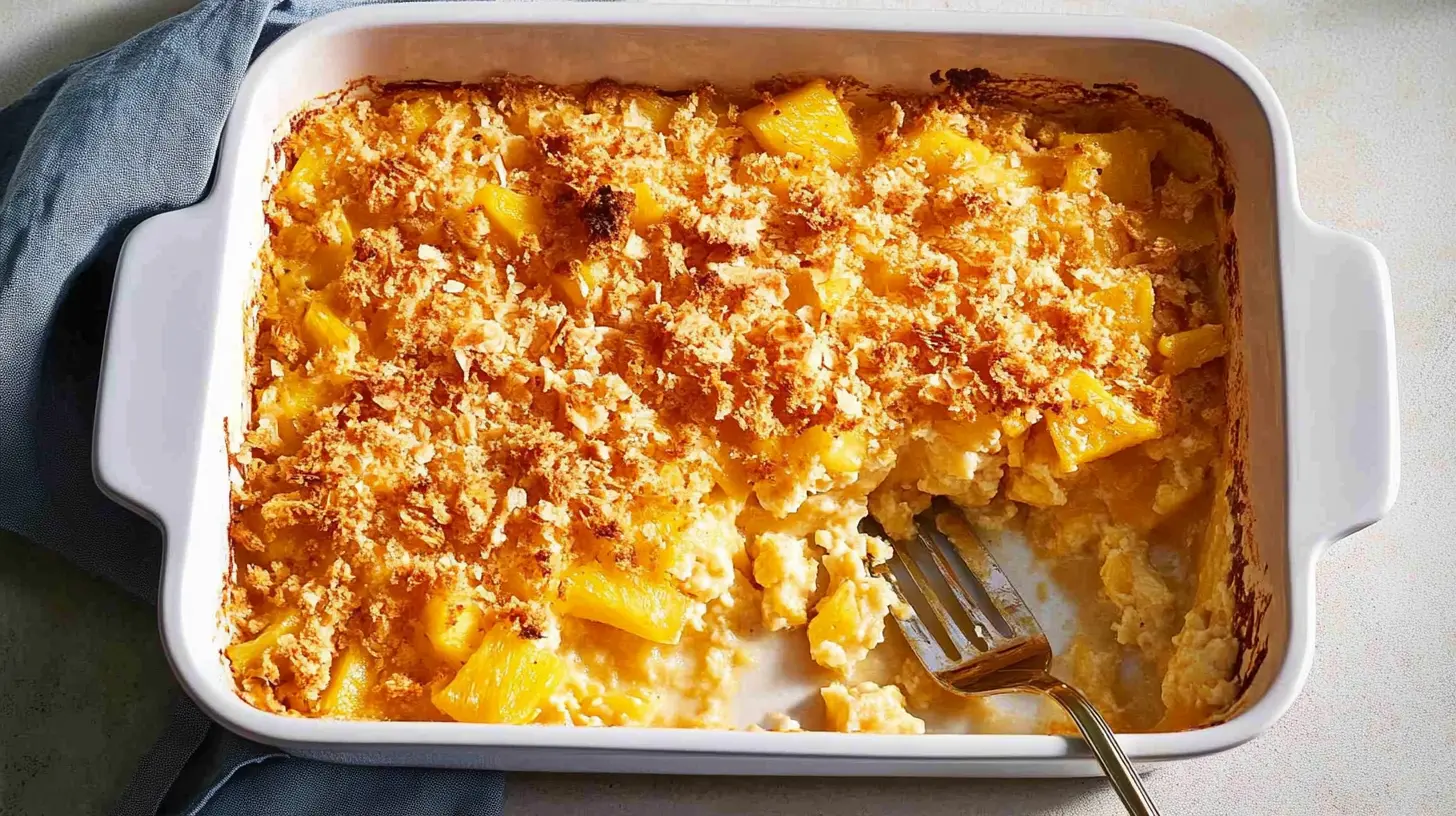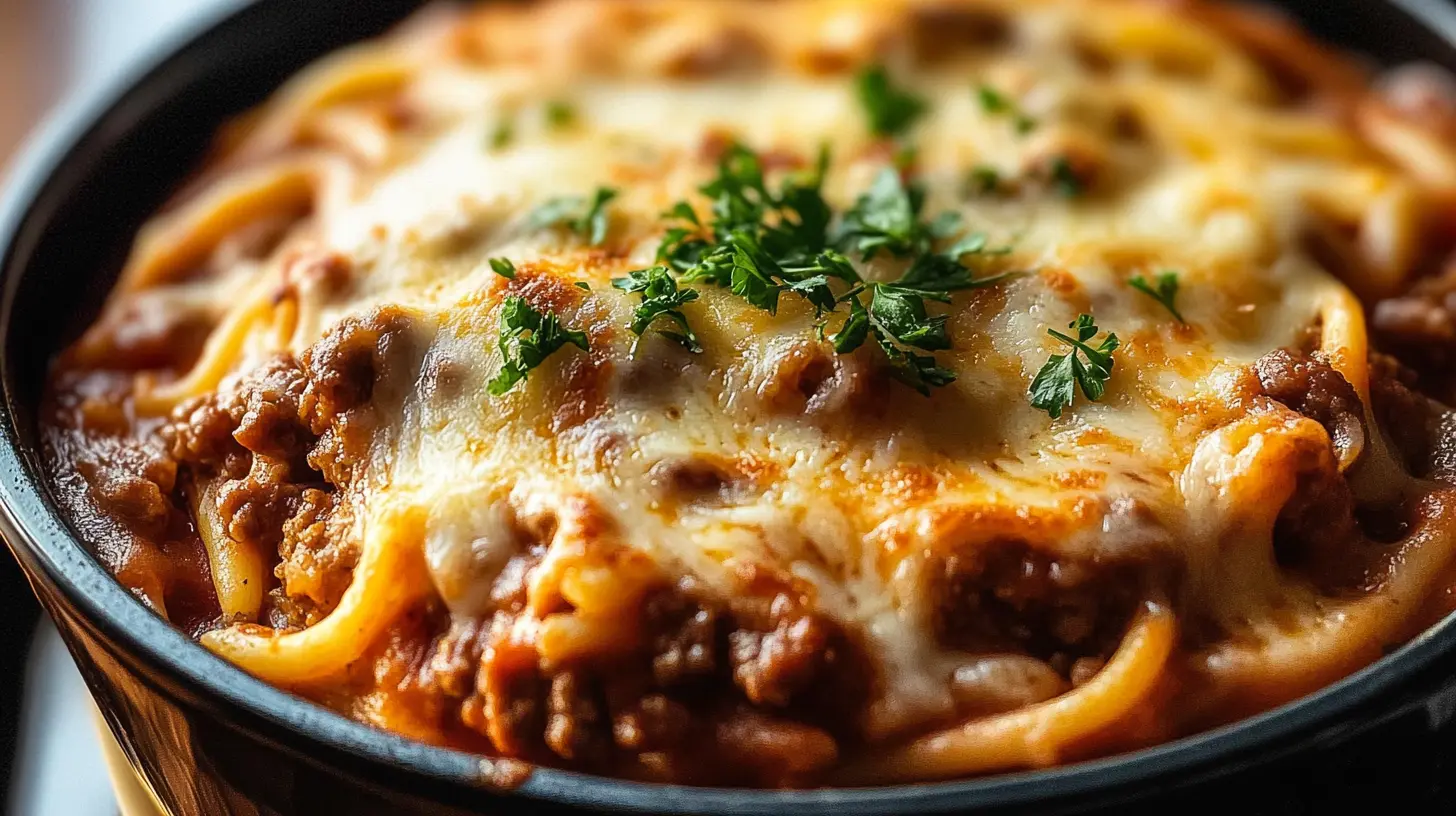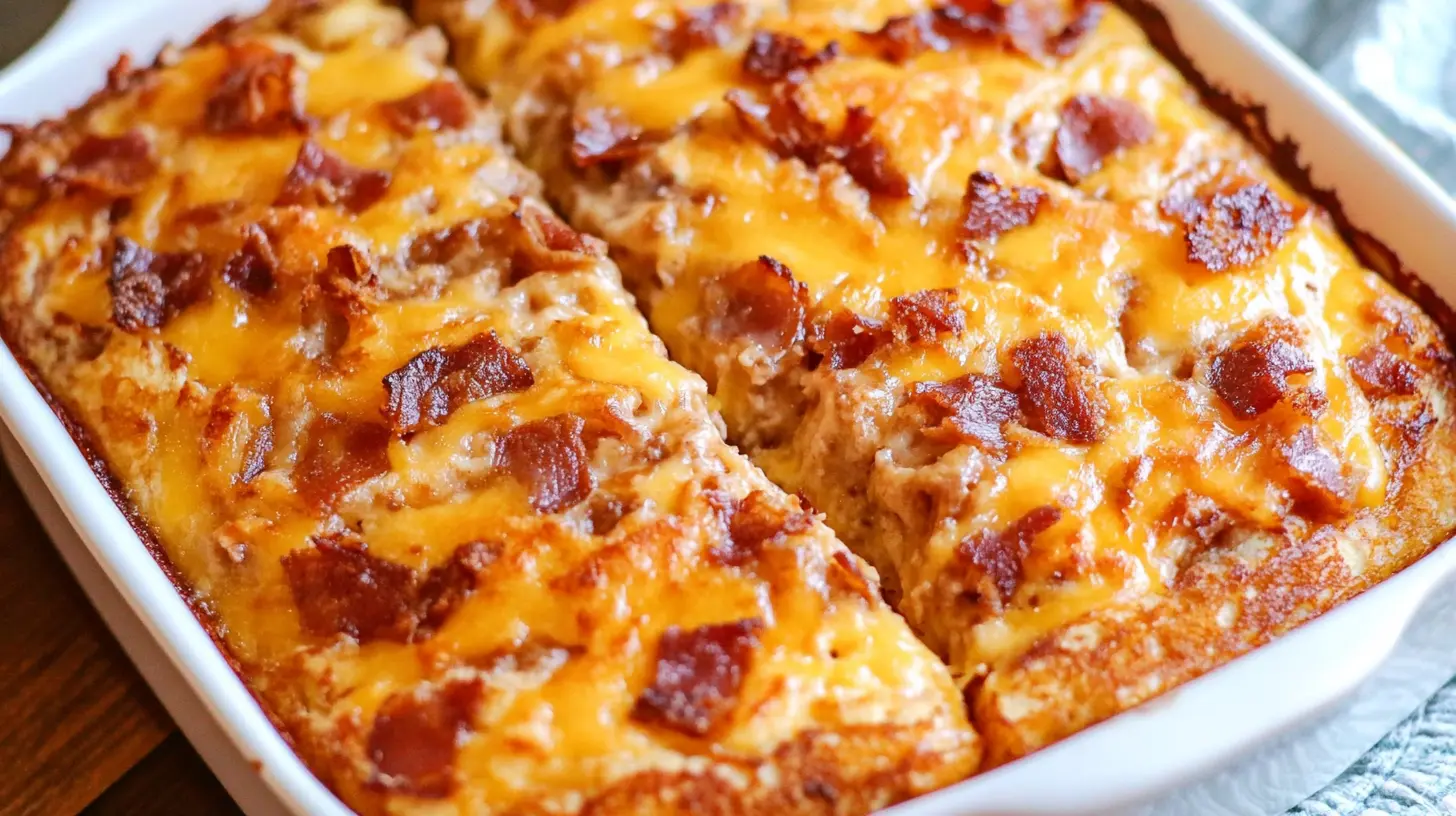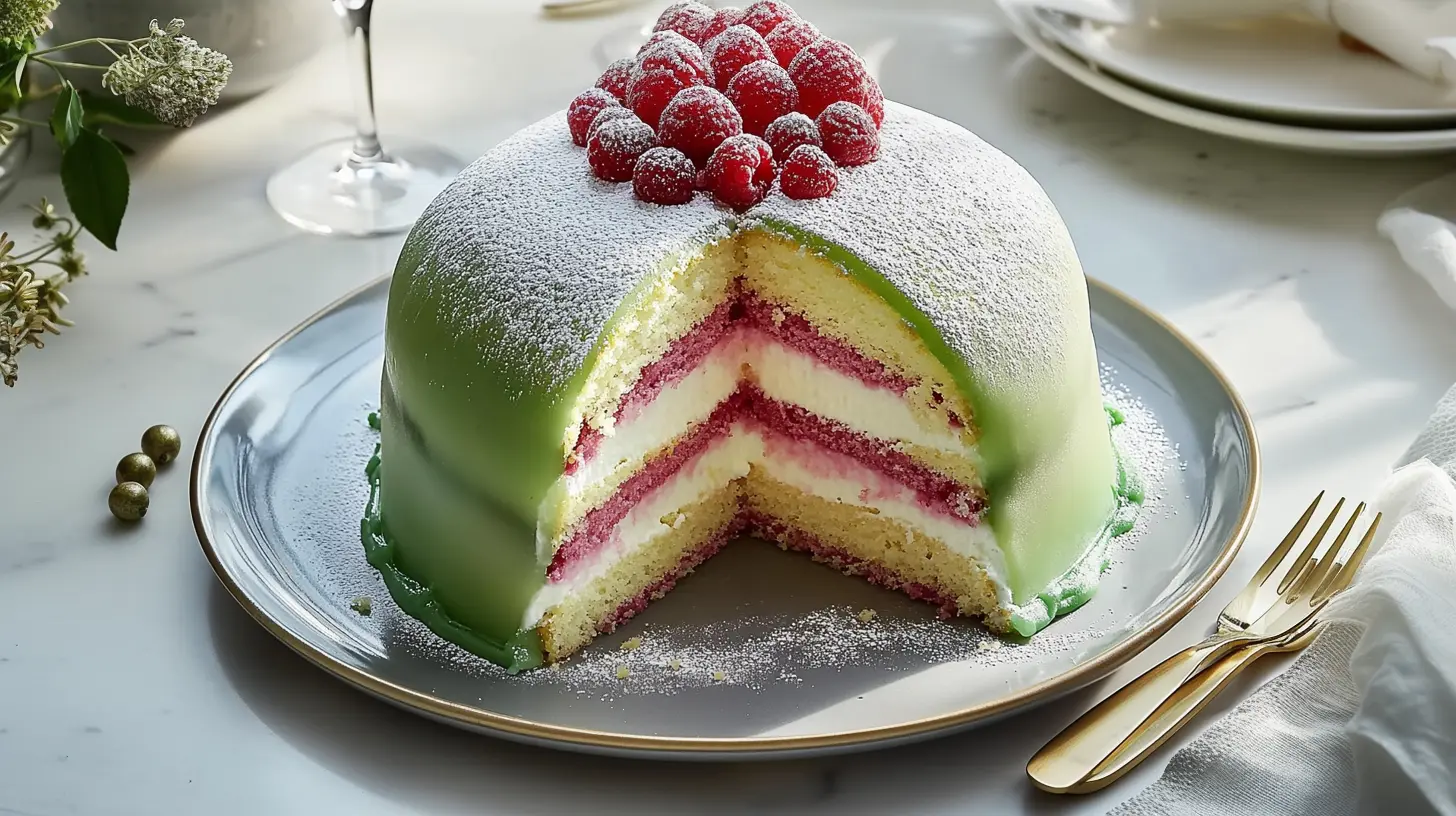Introduction to Pineapple Casserole
Pineapple casserole might seem unusual at first, but when you try it, you’ll quickly understand why many people love this Southern classic. Sweet pineapple combines with savory cheese and a crunchy cracker topping, creating a dish that’s both unique and delicious. This versatile casserole serves well as a side dish for holiday meals, a favorite at potlucks, or even a dessert, depending on your preferences.
For home cooks, busy parents, and food enthusiasts alike, pineapple casserole offers simplicity with a few basic ingredients that deliver lots of flavors. You can also easily adapt it to meet various dietary needs, making it the perfect dish for any gathering or dinner table. If you enjoy pineapple-based dishes, check out the Hawaiian pineapple cake recipe for more tropical dessert inspiration.
Benefits and Advantages of Pineapple Casserole
Easy to Prepare
One major advantage of pineapple casserole is its simplicity. With just a few basic ingredients, most of the work involves layering and mixing, allowing for quick assembly. It’s perfect for busy weeknights when you want something tasty without spending hours in the kitchen.
Versatile for Different Occasions
Pineapple casserole shines with its versatility. You can serve it as a side dish during holiday meals, such as Thanksgiving or Easter, where its sweetness complements savory mains like ham or roasted chicken. It also works well as a dessert, especially when you top it with a dollop of whipped cream. You can easily tailor the dish to fit your taste preferences by adjusting the sweetness or adding more savory ingredients.
Suitable for Various Diets
Pineapple casserole can easily be modified to meet different dietary needs. For those on gluten-free diets, swapping the traditional cracker topping for gluten-free options works perfectly. If you’re aiming for a lower-calorie version, reducing the sugar or using lighter cheeses does the trick. You can also adapt this casserole for vegan or lactose-intolerant individuals by using plant-based cheeses and non-dairy substitutes.
For more adaptable recipes, check out the sourdough sandwich bread recipe on Hailee Recipes for another dish that suits various dietary preferences.
Ingredients Overview
Essential Ingredients for Pineapple Casserole
- 2 cans (20 oz each) crushed pineapple (drained)
- 1 cup shredded cheddar cheese (you can use low-fat or dairy-free alternatives)
- 1 cup granulated sugar (or reduce to ¾ cup for a less sweet version)
- ¼ cup all-purpose flour (gluten-free flour can be used)
- 1 sleeve buttery crackers (such as Ritz; substitute gluten-free crackers if needed)
- ½ cup melted butter (you can use plant-based butter for a vegan option)
These simple ingredients combine to create a balanced sweet and savory dish that can be adjusted to meet various dietary requirements.
Dietary Substitutions to Customize Your Pineapple Casserole
- Gluten-Free Option: Replace the all-purpose flour with gluten-free flour and use gluten-free crackers to ensure the casserole is suitable for those avoiding gluten.
- Lower-Calorie Version: You can reduce the sugar to ½ cup or replace it with a natural sweetener like stevia. Additionally, using low-fat cheese or a reduced-fat cracker option can help cut down on calories without sacrificing flavor.
- Vegan Option: Use dairy-free cheese and plant-based butter, along with vegan-friendly crackers, to create a vegan version of this beloved dish. You’ll still get the sweet and savory combination, with a satisfying crunchy topping.
How to Prepare the Perfect Pineapple Casserole: Step-by-Step Guide
First Step: Preheat the Oven
Preheat your oven to 350°F (175°C) to ensure it’s ready when you assemble the casserole.
Second Step: Mix the Pineapple and Dry Ingredients
In a large bowl, combine the drained crushed pineapple, sugar, and flour. Mix until the pineapple is evenly coated with the sugar and flour mixture. This combination helps thicken the filling while balancing the sweetness.
Third Step: Add the Cheese
Stir in the shredded cheddar cheese. The sharpness of the cheddar creates a savory contrast to the sweetness of the pineapple, giving the dish its unique flavor profile. Make sure the cheese is evenly distributed throughout the pineapple mixture.
Fourth Step: Assemble the Casserole
Transfer the pineapple and cheese mixture to a greased 9×13-inch baking dish. Spread it out evenly, ensuring the pineapple mixture is level across the dish.
Fifth Step: Prepare the Cracker Topping
Crush the buttery crackers in a plastic bag or using a rolling pin until they form coarse crumbs. In a separate bowl, mix the cracker crumbs with the melted butter until they are evenly coated.
Sixth Step: Top the Casserole and Bake
Sprinkle the buttered cracker crumbs evenly over the pineapple mixture. Place the casserole in the preheated oven and bake for 25-30 minutes, or until the topping is golden brown and the edges are bubbly.
Seventh Step: Serve and Enjoy
Allow the casserole to cool for a few minutes before serving. You can serve it warm as a side dish or even as a dessert, depending on your preference.
This easy step-by-step guide ensures a perfectly balanced pineapple casserole every time, making it an ideal dish for any occasion.
Mastering Pineapple Casserole: Advanced Tips and Variations
Tips for Success
- Drain the pineapple thoroughly: Excess liquid can make the casserole too runny, so ensure that the crushed pineapple is well-drained before mixing.
- Balance sweetness and savoriness: If you prefer a more savory casserole, reduce the sugar or add a pinch of salt to the cracker topping.
- Add a crunchier topping: For an extra crispy topping, bake the casserole uncovered for the last 5 minutes or broil it briefly to brown the crackers.
Variations to Try
- Add chopped nuts: For added texture, mix in some chopped pecans or walnuts to the cracker topping.
- Incorporate ham or bacon: Turn this side dish into a savory-sweet entrée by adding diced ham or crumbled bacon to the pineapple mixture.
- Spicy Pineapple Casserole: Add a pinch of cayenne pepper or sliced jalapeños for a spicy kick.
For more advanced tips on casseroles, check out the meat lover’s pizza casserole for another bold-flavored dish.
How to Store Pineapple Casserole: Best Practices
Refrigeration:
Store any leftovers in an airtight container in the refrigerator for up to 3 days. To reheat, warm it in the oven at 350°F (175°C) for 10-15 minutes, or microwave individual portions until heated through.
Freezing:
Pineapple casserole can be frozen for up to 2 months. To freeze, allow the casserole to cool completely, then wrap it tightly with plastic wrap followed by a layer of aluminum foil. When you’re ready to serve, thaw it overnight in the refrigerator and reheat in the oven until it’s warmed through.
Nutritional Value of Pineapple Casserole
Here’s an approximate breakdown of the nutritional value per serving (based on 8 servings):
- Calories: 350
- Fat: 15g
- Carbohydrates: 45g
- Protein: 7g
- Sugars: 30g
- Sodium: 400mg
The exact nutritional content will depend on the specific brands and ingredients you use, especially if you make substitutions like reduced-fat cheese or gluten-free crackers.
FAQs: Frequently Asked Questions About Pineapple Casserole
Can I Make Pineapple Casserole Ahead of Time?
Yes! You can prepare pineapple casserole up to 24 hours in advance. Assemble the casserole, cover it tightly, and refrigerate until you’re ready to bake. When baking from cold, add an extra 5-10 minutes to the bake time.
Can I Use Fresh Pineapple Instead of Canned?
Absolutely! If you prefer using fresh pineapple, chop it into small pieces and drain any excess juice before adding it to the recipe. However, fresh pineapple may require a longer bake time to soften fully.
What Cheese Works Best for Pineapple Casserole?
Sharp cheddar is the traditional choice because its strong flavor balances the sweetness of the pineapple. However, you can experiment with other cheeses like gouda or mozzarella for a different flavor profile.
For more casserole inspiration, visit the lasagna pasta recipe for another creative dish.
What are the 5 components of a casserole?
A casserole traditionally consists of five basic components that come together to create a well-balanced dish:
- Protein: This could be meat like chicken, beef, or fish, or plant-based proteins like tofu or beans for a vegetarian option.
- Starch: Often a grain or pasta base like rice, potatoes, or noodles, which helps to provide substance and bulk to the casserole.
- Vegetables: Adding vegetables like onions, carrots, or green beans helps to enhance flavor and nutrition. Canned or fresh vegetables work depending on the recipe.
- Binder: A liquid or sauce that holds the casserole together. This could be anything from a cream-based sauce, broth, or even condensed soup.
- Topping: A crunchy or cheesy topping is added to the top layer to add texture and flavor. It could be breadcrumbs, crushed crackers, or cheese.
Together, these components create a balanced, flavorful, and filling meal in a single dish.
What is the main ingredient in a casserole?
The main ingredient of a casserole is typically the protein or starch. These provide the base for the dish and determine the overall flavor and heartiness of the meal. For instance, in a chicken casserole, chicken is the main ingredient. However, in some recipes, starch such as rice, pasta, or potatoes takes center stage and acts as the main filler.
Why is it called a casserole?
The term “casserole” comes from the French word casserole, which refers to a deep, ovenproof dish used for both cooking and serving. Over time, the word also came to refer to the food itself, often a dish that contains a mixture of ingredients baked together. The name emphasizes the cooking method in a large, deep dish, and it became a popular method for preparing family meals that can be served directly from the cooking vessel.
Learn more about the history of casseroles in this Wikipedia article on casseroles.
What cheese goes with pineapple?
Cheese and pineapple make a surprisingly great pair, and the best cheese to complement pineapple is sharp cheddar. The tangy sharpness of cheddar cuts through the sweetness of pineapple, creating a balanced, savory-sweet combination. Other cheeses that work well include:
- Mozzarella: Its mild flavor allows the pineapple to shine while adding creaminess.
- Cream Cheese: Commonly used in desserts or as a filling, cream cheese provides a soft, rich texture that contrasts with pineapple’s acidity.
- Gouda: The nutty, buttery flavor of Gouda pairs well with pineapple, especially in baked dishes like pineapple casserole.
What is the key to making a good casserole?
The key to making a good casserole lies in balance and texture. Here are some essential tips:
- Layering flavors: Use a variety of flavors—savory, sweet, and even spicy elements to create depth. Season every layer, from the protein to the vegetables and starch.
- Proper cooking temperature: Cook your casserole at the right temperature, usually between 350°F to 400°F (175°C to 200°C), ensuring all the components cook evenly.
- Texture contrast: Add a crunchy topping, such as breadcrumbs or crushed crackers, to contrast with the creamy or soft interior, which keeps the dish from becoming too mushy.
- Moisture control: Ensure the casserole is neither too dry nor too soupy by balancing the liquid content from broths, creams, or condensed soups.
What is the difference between a dish and a casserole?
A dish refers to any food prepared in a specific way or to any course in a meal. It can describe individual portions or family-sized servings. However, a casserole specifically describes a meal that you cook and often serve in a deep, ovenproof dish. The key difference lies in the fact that a casserole refers to both the meal and the cookware used to prepare it, while the term “dish” serves as a broader culinary term that applies to any type of food preparation.
What do Americans mean by casserole?
In American cuisine, a casserole refers to a hearty, baked dish made by layering ingredients such as meats, vegetables, and starches in a single dish, then baking them in the oven. The dish is often topped with cheese or breadcrumbs to add texture. Casseroles are popular in the U.S. because they are easy to prepare, can be made in large quantities, and serve as a full meal in just one dish
What’s the difference between a casserole and a lasagna?
While both casserole and lasagna are baked dishes, the key difference lies in composition:
- Casserole: Refers to a broader category of baked dishes that combine layers or mixtures of ingredients such as meats, vegetables, and starch, often topped with cheese or breadcrumbs.
- Lasagna: A specific type of casserole made with layers of wide, flat pasta, cheese, meat or vegetable fillings, and sauce (usually tomato or béchamel).
Lasagna is a type of casserole, but not all casseroles are lasagnas.
Conclusion
Casseroles are versatile, hearty dishes with a rich history that spans various cultures. Whether you’re making a pineapple casserole for a holiday meal or a traditional lasagna, understanding the core components and techniques is key to success. From France to America, casseroles have evolved into a beloved comfort food, thanks to their ease of preparation and adaptability. Whether savory or sweet, casseroles are perfect for serving large groups and satisfying diverse palates.
For more in-depth information on the origins and variations of casseroles, check out this Wikipedia article on casseroles.

Posted by: Hailee | June 21, 2024
I’m passionate about sharing sweet and savory recipes that I’ve meticulously tested and perfected in my own kitchen. Join me on this delicious journey to experience the best of culinary creativity.




